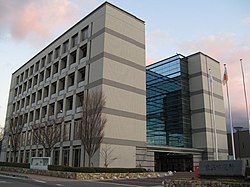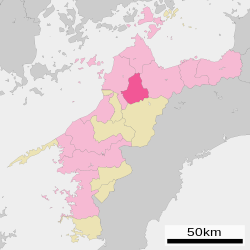
Ehime Prefecture is a prefecture of Japan located on the island of Shikoku. Ehime Prefecture has a population of 1,334,841 and has a geographic area of 5,676 km2. Ehime Prefecture borders Kagawa Prefecture to the northeast, Tokushima Prefecture to the east, and Kōchi Prefecture to the southeast.

Uwajima is a city located in Ehime Prefecture, Japan. As of 1 September 2022, the city had an estimated population of 70,440 in 35429 households and a population density of 150 persons per km2. The total area of the city is 468.19 square kilometres (180.77 sq mi).

Yawatahama is a city located in of Ehime Prefecture, Japan. As of 31 August 2022, the city had an estimated population of 31,385 in 15,638 households and a population density of 240 persons per km2. The total area of the city is 132.68 square kilometres (51.23 sq mi).

Saijō is a city in Ehime Prefecture, Japan. As of 1 September 2022, the city had an estimated population of 106,016 in 58,803 households and a population density of 210 persons per km2. The total area of the city is 509.98 square kilometres (196.90 sq mi).

Iyo is a city located in Ehime Prefecture, Japan. As of 31 March 2022, the city had an estimated population of 35,888 in 16169 households and a population density of 180 persons per km2. The total area of the city is 194.44 square kilometres (75.07 sq mi).

Uchiko is a town located in Kita District, Ehime Prefecture, Japan. As of 1 September 2023, the town had an estimated population of 15,153 in 7005 households and a population density of 52 persons per km2. The total area of the town is 299.43 square kilometres (115.61 sq mi).

Matsuno is a town located in Kitauwa District, Ehime Prefecture, Japan. As of 1 September 2022, the town had an estimated population of 3,693 in 1978 households, and a population density of 38 persons per km². The total area of the town is 98.45 square kilometres (38.01 sq mi).
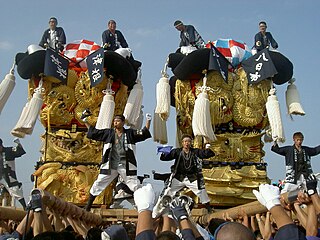
Shikokuchūō is a city located in Ehime Prefecture, Japan. As of August 31, 2022, the city had an estimated population of 83,635 in 28876 households and a population density of 200 persons per km². The total area of the city is 421.24 square kilometres (162.64 sq mi). Shikokuchūō is the leading producer of paper and paper products in Japan. It is also a port city and one of Ehime's major centers of industry.
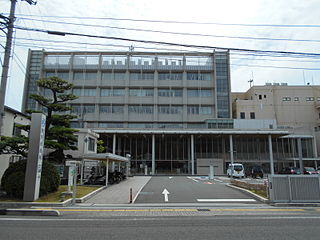
Seiyo is a city located in Ehime Prefecture, Japan. As of 31 August 2022, the city had an estimated population of 35,456 in 17627 households and a population density of 69 persons per km². The total area of the city is 514.34 square kilometres (198.59 sq mi).

Kumakōgen is a town in Kamiukena District, Ehime Prefecture, Japan. As of 1 August 2023, the town had an estimated population of 6,667 and a population density of about 11.4 persons per km2. The total area of the town is 583.69 square kilometres (225.36 sq mi).
National Route 11 is a Japanese highway on the island of Shikoku. The most important artery in Shikoku, it originates at the intersection with Routes 28, 55 and 195 in the prefectural capital of Tokushima and terminates at the intersection with Routes 33, 56, 317, 379, 440 and 494 in Matsuyama. Between the terminals, it passes through Naruto and Takamatsu, as well as other regional population centers. Route 11 measures 239.4 km in length.

Imabari is a city in Ehime Prefecture, Japan. It is the second largest city in the prefecture. As of 31 August 2022, the city had an estimated population of 152,111 in 75,947 households and a population density of 360 persons per km². The total area of the city is 468.19 square kilometres (180.77 sq mi). The population is the second largest in Ehime Prefecture after Matsuyama City.

Niihama is a city located in the eastern part of Ehime Prefecture, Japan. As of 31 July 2022, the city had an estimated population of 115,824 in 57781 households and a population density of 490 persons per km². The total area of the city is 234.50 square kilometres (90.54 sq mi). It has the third largest population in Ehime, behind the prefectural capital of Matsuyama and the recently expanded city of Imabari. It is famous for its Besshi copper mine as well as the annual Niihama Taiko Festival that is the center of annual drunken and boisterous activity and draws tourists from around the country.
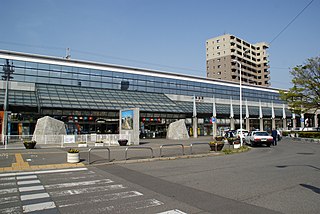
Imabari Station is a passenger railway station located in the city of Imabari, Ehime Prefecture, Japan. It is operated by JR Shikoku and has the station number "Y36".
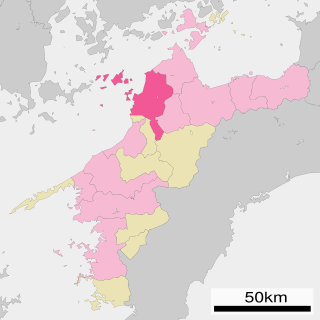
Ehime Prefectural Matsuyama Central Senior High School, abbreviated as Matsuyama Chuo or MCHS or MCH, is a public high school located in Ido-machi, Matsuyama, Ehime, Shikoku, Japan established in 1986 and opened in 1987 as the newest prefectural academic high school in Ehime Prefecture.

The Yokogawara Line is a 13.2 km railway line owned by Iyotetsu. The line connects Matsuyama with Tōon in Ehime Prefecture, Japan. The line runs eastwards from Matsuyama City Station, terminating at Yokogawara Station.

Aidai Igakubu Minamiguchi Station is a passenger railway station in the city of Tōon, Ehime Prefecture, Japan. It is on the Yokogawara Line, operated by Iyotetsu.

Minara Station is a passenger railway station in the city of Tōon, Ehime Prefecture, Japan. It is on the Yokogawara Line, operated by Iyotetsu. The station's mascot is a statue of Mazinger Z.

Tanokubo Station is a passenger railway station in the city of Tōon, Ehime Prefecture, Japan. It is on the Yokogawara Line, operated by Iyotetsu.
